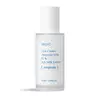What's inside
What's inside
 Key Ingredients
Key Ingredients

 Benefits
Benefits

 Concerns
Concerns

 Ingredients Side-by-side
Ingredients Side-by-side

Water
Skin ConditioningMilk Extract
Skin ConditioningButylene Glycol
HumectantCaprylic/Capric Triglyceride
MaskingGlycerin
HumectantNiacinamide
Smoothing1,2-Hexanediol
Skin ConditioningPentaerythrityl Tetraethylhexanoate
EmollientCetearyl Alcohol
EmollientPolyglyceryl-10 Stearate
Skin ConditioningCarbomer
Emulsion StabilisingArginine
MaskingButyrospermum Parkii Butter
Skin ConditioningEthylhexylglycerin
Skin ConditioningAdenosine
Skin ConditioningXanthan Gum
EmulsifyingDipotassium Glycyrrhizate
HumectantAllantoin
Skin ConditioningPanthenol
Skin ConditioningHydrogenated Lecithin
EmulsifyingSodium Hyaluronate
HumectantSucrose Stearate
EmollientCeramide NP
Skin ConditioningCeramide AP
Skin ConditioningCeramide As
Skin ConditioningCeramide Ng
Skin ConditioningTremella Fuciformis Polysaccharide
Emulsion StabilisingBeta-Glucan
Skin ConditioningGlycosphingolipids
EmollientCaprylyl Glycol
EmollientPotassium Hyaluronate
Skin ConditioningHydroxypropyltrimonium Hyaluronate
Hydrolyzed Sodium Hyaluronate
Skin ConditioningHydrolyzed Hyaluronic Acid
HumectantHyaluronic Acid
HumectantSoluble Collagen
HumectantPentylene Glycol
Skin ConditioningSodium Hyaluronate Crosspolymer
HumectantSodium Acetylated Hyaluronate
HumectantWater, Milk Extract, Butylene Glycol, Caprylic/Capric Triglyceride, Glycerin, Niacinamide, 1,2-Hexanediol, Pentaerythrityl Tetraethylhexanoate, Cetearyl Alcohol, Polyglyceryl-10 Stearate, Carbomer, Arginine, Butyrospermum Parkii Butter, Ethylhexylglycerin, Adenosine, Xanthan Gum, Dipotassium Glycyrrhizate, Allantoin, Panthenol, Hydrogenated Lecithin, Sodium Hyaluronate, Sucrose Stearate, Ceramide NP, Ceramide AP, Ceramide As, Ceramide Ng, Tremella Fuciformis Polysaccharide, Beta-Glucan, Glycosphingolipids, Caprylyl Glycol, Potassium Hyaluronate, Hydroxypropyltrimonium Hyaluronate, Hydrolyzed Sodium Hyaluronate, Hydrolyzed Hyaluronic Acid, Hyaluronic Acid, Soluble Collagen, Pentylene Glycol, Sodium Hyaluronate Crosspolymer, Sodium Acetylated Hyaluronate
Water
Skin ConditioningGlycerin
HumectantIsopropyl Myristate
EmollientGlyceryl Stearate Citrate
EmollientCetearyl Alcohol
EmollientCaprylic/Capric Triglyceride
MaskingEnantia Chlorantha Bark Extract
Skin ConditioningTocopherol
AntioxidantHelianthus Annuus Seed Oil
EmollientAloe Barbadensis Leaf Juice Powder
Skin ConditioningButylene Glycol
HumectantXanthan Gum
EmulsifyingAllantoin
Skin ConditioningEthylhexylglycerin
Skin ConditioningOleanolic Acid
Skin ConditioningSodium Hydroxide
BufferingCitric Acid
BufferingPhenoxyethanol
PreservativeBenzoic Acid
MaskingDehydroacetic Acid
PreservativeWater, Glycerin, Isopropyl Myristate, Glyceryl Stearate Citrate, Cetearyl Alcohol, Caprylic/Capric Triglyceride, Enantia Chlorantha Bark Extract, Tocopherol, Helianthus Annuus Seed Oil, Aloe Barbadensis Leaf Juice Powder, Butylene Glycol, Xanthan Gum, Allantoin, Ethylhexylglycerin, Oleanolic Acid, Sodium Hydroxide, Citric Acid, Phenoxyethanol, Benzoic Acid, Dehydroacetic Acid
 Reviews
Reviews

Ingredients Explained
These ingredients are found in both products.
Ingredients higher up in an ingredient list are typically present in a larger amount.
Allantoin is a soothing ingredient known for its protective and moisturizingg properties. Because of this, it is often added to products with strong active ingredients.
Studies show higher concentrations of this ingredient can promote wound healing.
Though it can be derived from the comfrey plant, allantoin is produced synthetically for cosmetic products to ensure purity.
Learn more about AllantoinButylene Glycol (or BG) is used within cosmetic products for a few different reasons:
Overall, Butylene Glycol is a safe and well-rounded ingredient that works well with other ingredients.
Though this ingredient works well with most skin types, some people with sensitive skin may experience a reaction such as allergic rashes, closed comedones, or itchiness.
Learn more about Butylene GlycolThis ingredient is an emollient, solvent, and texture enhancer. It is considered a skin-softener by helping the skin prevent moisture loss.
It helps thicken a product's formula and makes it easier to spread by dissolving clumping compounds.
Caprylic Triglyceride is made by combining glycerin with coconut oil, forming a clear liquid.
While there is an assumption Caprylic Triglyceride can clog pores due to it being derived from coconut oil, there is no research supporting this.
Learn more about Caprylic/Capric TriglycerideCetearyl alcohol is a mixture of two fatty alcohols: cetyl alcohol and stearyl alcohol. It is mainly used as an emulsifier. Emulsifiers help prevent the separation of oils and products. Due to its composition, it can also be used to thicken a product or help create foam.
Cetearyl alcohol is an emollient. Emollients help soothe and hydrate the skin by trapping moisture.
Studies show Cetearyl alcohol is non-toxic and non-irritating. The FDA allows products labeled "alcohol-free" to have fatty alcohols.
This ingredient is usually derived from plant oils such as palm, vegetable, or coconut oils. There is debate on whether this ingredient will cause acne.
Due to the fatty acid base, this ingredient may not be Malassezia folliculitis safe.
Learn more about Cetearyl AlcoholEthylhexylglycerin (we can't pronounce this either) is commonly used as a preservative and skin softener. It is derived from glyceryl.
You might see Ethylhexylglycerin often paired with other preservatives such as phenoxyethanol. Ethylhexylglycerin has been found to increase the effectiveness of these other preservatives.
Glycerin is already naturally found in your skin. It helps moisturize and protect your skin.
A study from 2016 found glycerin to be more effective as a humectant than AHAs and hyaluronic acid.
As a humectant, it helps the skin stay hydrated by pulling moisture to your skin. The low molecular weight of glycerin allows it to pull moisture into the deeper layers of your skin.
Hydrated skin improves your skin barrier; Your skin barrier helps protect against irritants and bacteria.
Glycerin has also been found to have antimicrobial and antiviral properties. Due to these properties, glycerin is often used in wound and burn treatments.
In cosmetics, glycerin is usually derived from plants such as soybean or palm. However, it can also be sourced from animals, such as tallow or animal fat.
This ingredient is organic, colorless, odorless, and non-toxic.
Glycerin is the name for this ingredient in American English. British English uses Glycerol/Glycerine.
Learn more about GlycerinWater. It's the most common cosmetic ingredient of all. You'll usually see it at the top of ingredient lists, meaning that it makes up the largest part of the product.
So why is it so popular? Water most often acts as a solvent - this means that it helps dissolve other ingredients into the formulation.
You'll also recognize water as that liquid we all need to stay alive. If you see this, drink a glass of water. Stay hydrated!
Learn more about WaterXanthan gum is used as a stabilizer and thickener within cosmetic products. It helps give products a sticky, thick feeling - preventing them from being too runny.
On the technical side of things, xanthan gum is a polysaccharide - a combination consisting of multiple sugar molecules bonded together.
Xanthan gum is a pretty common and great ingredient. It is a natural, non-toxic, non-irritating ingredient that is also commonly used in food products.
Learn more about Xanthan Gum